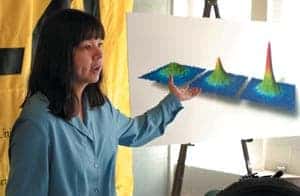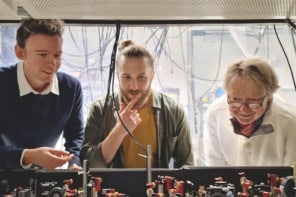The creation of the first fermionic condensate will herald a new generation of research into the properties of superfluids and superconductors

Since the first gaseous Bose-Einstein condensate was created in 1995, the field of ultracold matter has developed rapidly. We all knew from the start, however, that the potential for the field would explode if condensates could be made from fermions as well as bosons. For this reason, we were stunned and delighted to learn that Deborah Jin, Cindy Regal and Markus Greiner at the JILA laboratory in the US have created the first fermionic condensate by cooling a gas of potassium atoms to nanokelvin temperatures (Phys. Rev. Lett. 92 040403). Known as “holy grail two” in the ultracold-matter community, fermionic condensates could have an enormous impact on other areas of physics as well.
A Bose-Einstein condensate is a peculiar phase of matter in which all the particles in a system occupy the same quantum state. However, this can only happen if the particles are bosons – particles that have spins of h-bar, 2h-bar and so on, where h-bar is Planck’s constant divided by 2π. Bose-Einstein condensates have been made from several different types of bosonic atoms, such as rubidium and sodium, by cooling the atoms to just above absolute zero.
Atoms like potassium-40, on the other hand, are forbidden by quantum mechanics from occupying the same state because they are fermions – particles with spins of h-bar/2, 3h-bar/2 and so on – and must therefore obey the Pauli exclusion principle. The only way to make a fermionic condensate is to try and persuade the fermionic atoms to form bosonic pairs. The pairing of electrons (which are fermions) to produce a condensate is a crucial feature of superconductivity, so a fermionic condensate would give us crucial insights into the mechanisms behind superconductivity, as well as superfluidity.
The magic technique
To say that making a fermionic condensate is tough is to severely understate the experimental challenges involved. The prospect of achieving it, however, was so exciting that it became the goal of many groups around the world.
The first observation of degenerate Fermi gases was made by Jin and colleagues at JILA – which is run jointly by the University of Colorado at Boulder and the National Institute of Standards and Technology – in 1999. This ultracold result was very encouraging, but it was not quite cold enough. To be precise, it was cold enough for the particles to display the effects of the exclusion principle, as discerned from the shape of the atomic cloud, but not cold enough for the fermions to pair up (see “A Fermi gas of atoms”).
In 1998 Wolfgang Ketterle and co-workers at the Massachusetts Institute of Technology (MIT) had first demonstrated the technique that allows the interactions between ultracold atoms to be controlled, thus making a true fermionic condensate possible. This technique takes advantage of resonant scattering between atoms, and allows the strength of the interactions between the atoms to be tuned with an external magnetic field (see “Quantum gases come of age”). The phenomenon – which is known as a Feshbach resonance – arises when the kinetic energy of a pair of colliding atoms that have one particular spin orientation is close to the kinetic energy corresponding to a quasi-bound pair of atoms with a different spin configuration.
During a collision, the incoming atoms with one spin configuration are coupled to the other configuration, and the pair may or may not form a bound state. It turns out that on one side of the resonance – which corresponds to lower magnetic-field values in the case of potassium-40 – there is a conventional, yet very weakly bound, molecular state. On the other side of the resonance there is no bound state, even though the long-range interaction between the particles is effectively attractive.
It might seem at first that the force between atoms is always attractive at long distances due to van der Waals interactions, but this is not the case. At the very long distances relevant for ultralow-energy encounters, the effective interaction between particles can be attractive or repulsive. The combined effect of such an effective attraction and the presence of other particles is known to produce Bardeen-Cooper-Schrieffer (BCS) pairing, which is the generic mechanism behind superfluidity and superconductivity.
In 2001 theorists, in particular Murray Holland at JILA and Eddy Timmermans at Los Alamos, showed that the Feshbach-resonance technique could be used to observe superfluidity in atomic fermionic systems. This set the stage for a frantic race to produce such a state, which included the groups at the LENS laboratory in Florence, Duke University in North Carolina, the University of Innsbruck, Rice University in Texas and the Ecole Normale Supérieure in Paris, as well as the MIT and JILA teams.
A smoking gun
In 2003 the last five of these groups produced ultracold molecules by causing pairs of fermionic atoms to associate with one another at a Feshbach resonance. The next question was whether these weakly bound molecules could survive long enough for the gas to be cooled down to the temperatures required for Bose-Einstein condensation?
Fortunately, the lifetime of these molecules increases as one approaches a Feshbach resonance, and towards the end of 2003 the JILA, Innsbruck and MIT teams observed Bose-Einstein condensation in molecules. This was a fantastic advance, but little did we know of the excitement ahead: the other side of the resonance, which does not support a bound state for individual pairs of atoms, was still hiding its treasures. On this side, which is explored by applying higher magnetic-field values, long-range pairing between atoms is possible due to the combined effect of interactions and the exclusion principle.
To form the new fermionic condensate, the JILA researchers exploited the Feshbach resonance in two ways in a gas of potassium-40 atoms. First, they tuned the magnetic field to a value corresponding to an effective interparticle attraction, and allowed the gas to equilibrate. Next, they rapidly decreased the value of the magnetic field, sweeping it across the Feshbach resonance to the side that supports a weakly bound molecular state. The magnetic field is spatially constant, so it does not change the speed of the centre-of-mass of an atomic pair. The sweep is also sufficiently rapid to avoid any changes in the overall speed of the atoms due to collisions.
As a result, the initial distribution of the centre-of-mass speeds of the fermionic pairs is the same as the distribution for the molecules after the magnetic sweep. Jin and co-workers then measured this speed distribution and found that it was exactly the type one gets from of a Bose-Einstein condensate. In this way, the JILA result is the “smoking gun” of a fermionic condensate.
One of the most important consequences of the production of a fermionic condensate is that it enables ultracold atoms to be used to study the crossover between conventional superfluidity in the BCS limit and the superfluidity of molecules. This crossover may well be relevant to high-temperature superconductivity. It will also allow us to study strongly interacting many-body systems, such as “Bertsch nuclei” in nuclear physics. With such an exquisite degree of control over ultracold matter, we can also hope that it will ultimately be possible to elucidate the internal structure of the fermionic pairs.



